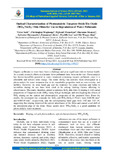Optical Characterization of Photocatalytic Tungsten Oxide/Tin Oxide (𝐖𝐎𝟑/𝐒𝐧𝐎𝟐) Thin Films for Use in Degradation of Water Pollutants

View/
Date
2023Author
Isahi, Victor
Maghanga, Christopher
Mwamburi, Mghendi
Munyati, Onesmus
Hatwaambo, Sylvester
Akoto, Emmanuel
Isoe, Wycliffe
Waqas Alam, Mir
Metadata
Show full item recordAbstract
Organic pollutants in water have been a challenge and pose significant risks to human health. As a result, research efforts to eliminate these pollutants have been on the rise. Photocatalysis has shown incredible potential in water treatment containing organic pollutants since it is affordable and utilizes solar energy. Tin oxide (SnO2) has ardently been investigated as a photocatalyst for water treatment due to its remarkable properties such as; non-toxicity, and stability. However, its wide band gap and the tendency for some electrons and holes to recombine during its use have been cited to be among limiting factors affecting its effectiveness. This study, therefore, aimed to optimize SnO2 thin films by doping it with varied proportions of Tungsten oxide (WO3) using Sol-gel technique and investigating the effects of WO3 doping on the optical and photocatalytic properties of the prepared films. From the results, the calculated rate constants for SnO2 and WO3/SnO2(1.5%wt.) were 0.00256 min-1 and 0.00519 min-1, respectively, and the corresponding band gaps were 3.82 and 3.03 eV, suggesting that doping improved the optical absorbance of the films and caused a red shift of the absorption edge of the films. These results show WO3/SnO2 is a good candidate for photocatalytic water treatment.
